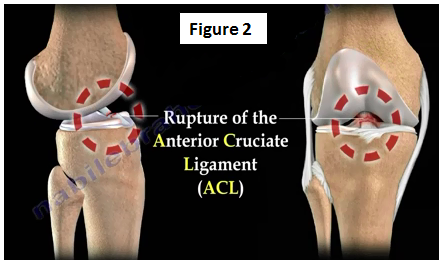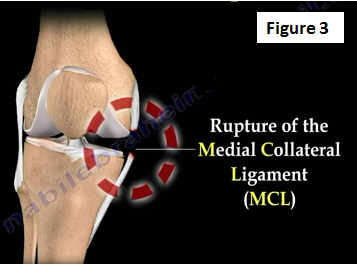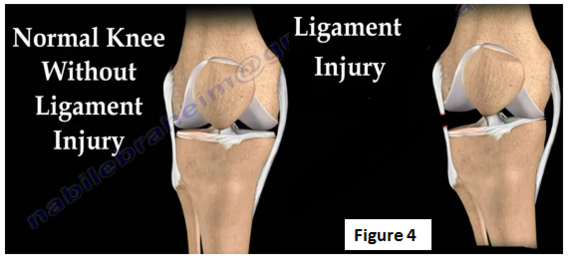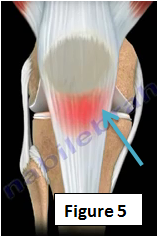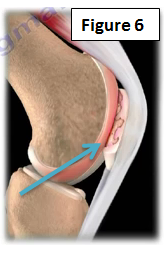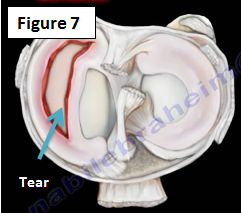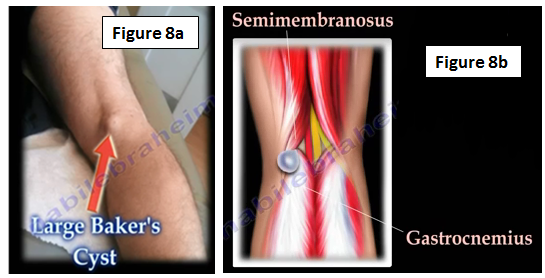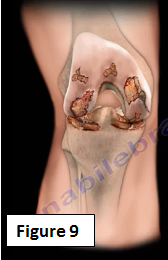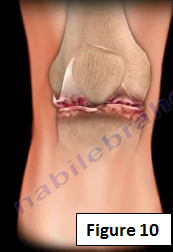Knee pain is very common and it can be either severe and disabling or mild and transient. In this article we list the most common causes of knee pain.
Patellar Bursitis:
Patellar bursitis is characterized by pain and inflammation located near the knee joint (Figure 1). The bursa becomes inflamed and fills with fluid. This condition causes pain, swelling, tenderness and a lump in the area on top of the kneecap.
Anterior Cruciate Ligament Tear (ACL):
This type of tear involves a valgus stress to the knee (Figure 2). Usually the patient will have swelling and a hematoma. A hemorrhage in the knee will indicate an ACL tear in 80% of patients. An ACL tear may have an associated meniscal tear. The Lachman's Test will be positive with this type of tear. An MRI is used to diagnose this type of injury. Tears of the ACL are more common in females. Multiple factors including landing mechanics, neurovascular, genetic, and anatomic differences between males and females contribute to this.
Medial Collateral Ligament Rupture (MCL):
An MCL tear is an injury to the ligament on the inner part of the knee (Figure 3). This a common injury. A knee brace may decrease the incidence of this injury.
Lateral Collateral Ligament Rupture (LCL):
An LCL tear usually occurs as a result of sports activities (Figure 4). This type of ligament injury is rare.
Patellar Tendonitis:
Patellar Tendonitis is described by inflammation and pain located inferior to the kneecap area (Figure 5).
Patellar Chondromalacia:
Patellar chondromalacia is chronic pain due to softening of the cartilage beneath the knee cap (Figure 6). The cartilage will have erosions that range from mild to complete in the joint surface of the kneecap. The pain is felt in the front of the knee and occurs more often in younger people. It is worsened from climbing up and down stairs.
Treatment:
Treatment usually involves a specific therapy and the patient may be given NSAIDs (nonsteroidal anti-inflammatory medications). Surgery is rare in patients with patellar chondromalacia.
Meniscal Tear:
The inner part of the meniscus is lacking a blood supply. This area is unable to heal by itself. The outer area (outer 30%) of the meniscus is rich in blood supply. If there is any peripheral tear to the outer area, the tear will be sutured and will heal (Figure 7). The meniscus is the cushion that protects the cartilage of the knee. Injury to it will cause pain on the medial or the lateral side of the knee. The most specific sign is pain in the joint line itself. The tear will present itself with a history of locking, swelling and instability of the knee. McMurray's test is usually positive and an MRI is helpful in diagnosing.
Baker's Cyst:
Baker's cyst is swelling in the back of the knee that is filled with synovial fluid (Figure 8a). This cyst usually occurs between the semimembranosus and medial gastrocnemius muscles (Figure 8b). It can occur due to a meniscal tear.
Arthritis of the Knee Joint:
This is characterized by progressive wearing away of the cartilage of the joint (Figure 9). The knee is a common part of the body that is affected by arthritis. You will find that the joint space will be narrowed or you will find bone-on-bone in the x-rays.
Gout:
Gout is an inflammatory arthritis that is caused by an excessive level of uric acid in the blood (Figure 10). It can affect any joint in the body, especially the big toe. The crystals will look like needles and have a negative birefringence. The knee joint is more commonly affected by pseudogout. Pseudogout is a metabolic disease where calcium pyrophosphate dehydrate crystals are formed within a joint space and can be painful.
For more information about knee pain, check out my YouTube video:
https://www.youtube.com/watch?v=FMXAJhtM1ZA
https://www.youtube.com/watch?v=SnfEmezg7eY
https://www.youtube.com/watch?v=G9MPgxiZnoc
For more videos, visit my YouTube channel:
https://www.youtube.com/user/nabilebraheim

